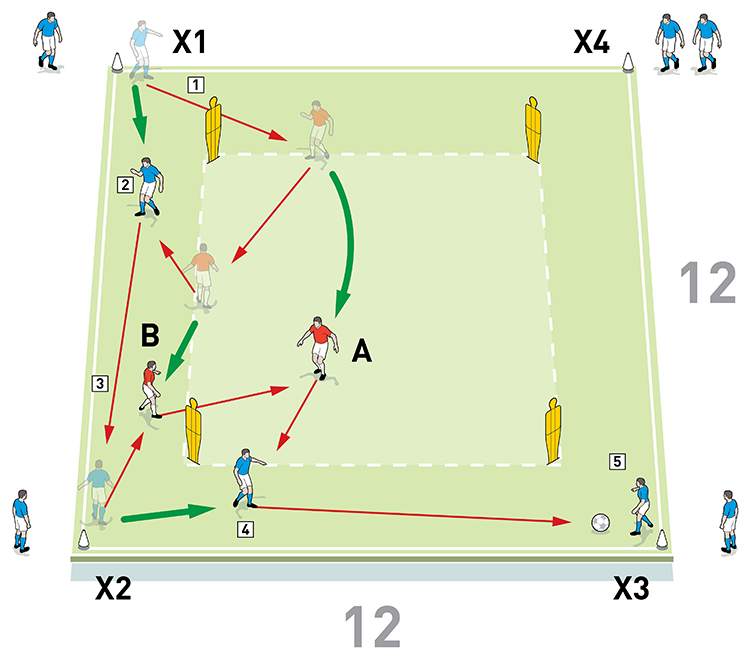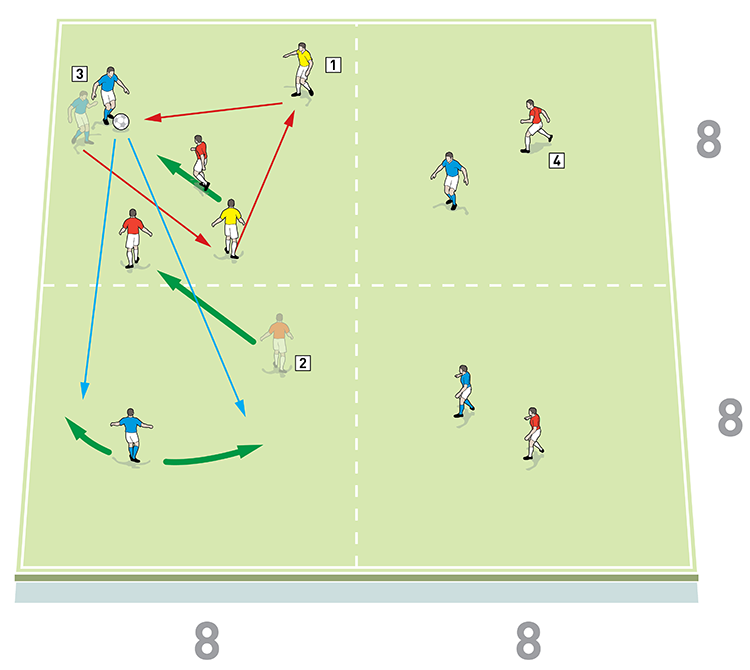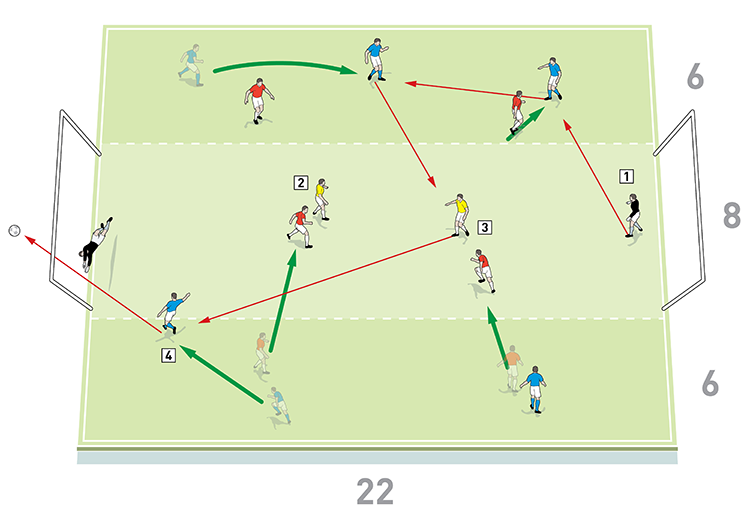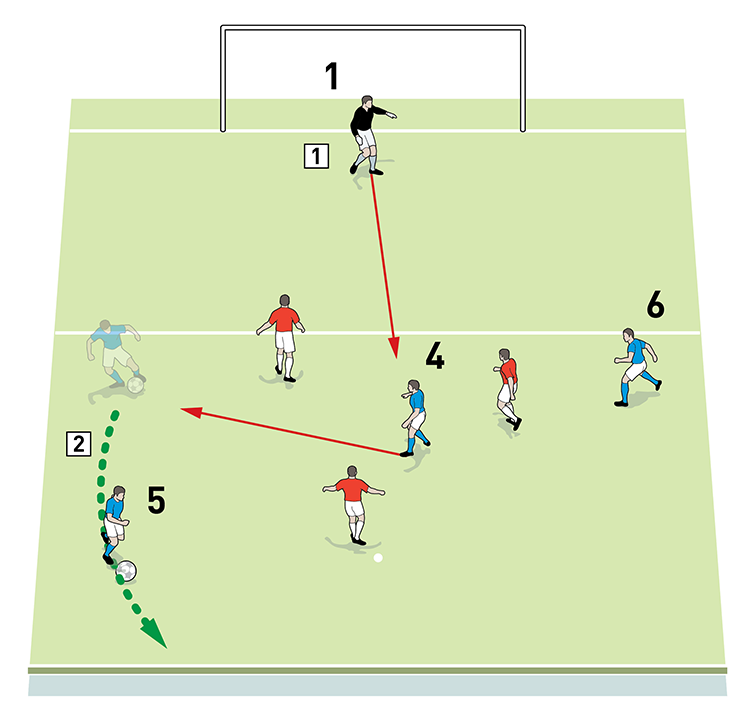You are viewing 1 of your 1 free articles
Finding the third man
This session is about encouraging players to work in threes, using passing combinations to find the third man free of his defender. This concept is a huge part of our possession style at Fulham.
| Area | Up to 22x20 yards |
| Equipment | Balls, bibs, cones, mannequins, 2 goals |
| No. of Players | 10 players + 2 goalkeepers |
| Session Time |
Passing practice: 10mins, Possession practice: 25mins, Small-sided game: 25mins |
This session is about encouraging players to work in threes, using passing combinations to find the third man free of his defender. This concept is a huge part of our possession style at Fulham.
The players love this session because it is all about being pro-active and dominating possession, which is our philosophy as a team. Crucially, they see it has a real relevance to the way we play and it clearly translates to our match-day performances. The session builds in a really nice way – it goes from a passing practice to a possession activity and culminates in a positional game.
The concept of finding the third man runs through every single practice we do, which is why we are able to dominate the ball so effectively in games. Of course, we practise this in many different guises, but this session in particular will come out once a month. If we know our next opponent is a pressing team, we will do this session more frequently as we know we will need to be effective in our build-up play by bouncing around the pressers.
What do I get the players to do?
Passing practice
We set up an area of 12x12 yards. Inside is a smaller area of 9x9 yards, marked with a mannequin at each corner. We’re using 10 players, divided into two reds and eight blues. The reds are players A and B and they work in the centre of the area and their role is to help form passing triangles around the mannequins. Two blues start on each corner of the main area – the corners are labelled X1, X2, X3 and X4.
Play starts with a pass from the first player at X1 to player A in the centre, who plays a first-time bounce pass to player B, as shown [1]. Player B sets up X1 who has moved along the line. X1 passes to X2 and follows the pass. Player B now drops short to receive from X2 and then bounces to player A, who has moved to receive. X2 goes down the line to receive from A and passes to X3 and follows the pass to the next corner. Play continues and the same sequence is now repeated on the opposite side with X3 and X4.
1

2. Red player B sets up blue X1, who has moved along the line to receive and then passes to X2 and follows the pass
3. Red player B now drops short to receive from blue X2 and bounces to player A
4. Blue X2 goes down the line to receive from red player A, passes to X3 and follows the pass to the next corner
5. The sequence continues on the other side, starting with the first player at X3
The key coaching messages here revolve around footwork and the need for quick body preparation ready to face the next man.
We play for 45 seconds and then one of the blue pairs switch with players A and B. In total we play 10 blocks of 45 seconds, with each pair having two turns in the centre as A and B.
How do I progress the session?
Possession practice
We progress the session from an unopposed passing practice by introducing the concept of possession, with players trying to retain the ball under pressure from their opponents.
We set up a 16x16-yard grid made up of four 8x8-yard boxes. We’re using 10 players, split into four reds, four blues and two yellow floaters who play for the team in possession. There is a 1v1 between the blues and reds in each zone. The blues start with the ball in the zone with the floaters, giving the possession players a 3v1 advantage.
After three passes have been made, an opposition player can enter from another zone to make it a 3v2. This creates a ‘free man’ in one of the boxes and the possession team must now find him with a pass, as shown [2]. He should be on his toes to make an angle for the pass.
2

2. Here the team scores a point for hitting their target of seven passes under pressure
3. Once players have mastered the activity, limit the number of touches they can take
4. If the defending team wins possession, they should quickly counter-attack
The floaters follow the ball into the new box and the presser returns, allowing play to continue in the new box.
If the red pressing team wins the ball, they become the new attacking team and play continues with the blues now counter-pressing.
We play for 10 blocks of two minutes. Each pair takes two turns in the floating role. We rest players for 30 seconds between blocks.
What do I get the players to do next?
Small-sided game
We set up an area of 22x20 yards with a goal and a goalkeeper at each end. The playing area is split lengthways into two wide zones of six yards each and an eight-yard central zone.
We’re using 10 outfield players, split into two teams of four and two yellow floaters, who play for the team in possession. The game is directional and the floaters are locked into the central zone, while two reds and two blues start in each wide zone.
Play starts with a pass out from one of the keepers. The defenders should try to close off passes into the centre and press from the inside to the outside, while the possession team must combine with each other and with the floaters to draw defenders into the central zone in order to create a ‘free man’ who can receive the ball unmarked in an attacking position, as shown [3]. The aim is to score but it must be with a one-touch finish. There are no offsides. Play restarts from the opposition keeper. We play five games of four minutes each.
3

2. After three passes, an opponent can enter from another zone and press, making it 3v2 in the box with the ball
3. The possession team must find a way to pass to the ‘free man’ who has been left alone in his box. The floaters follow the ball into the box. The defender then returns and play continues with a new 3v1
4. If a red defender wins the ball, the reds become the new possession team and the blues transition to counter-pressing
How would you put this into a game situation?
Phases of play
Here we show some examples of tactical ‘third man’ combinations in our 4-3-3 positional game. For example, we can use a third man combination when the goalkeeper plays the ball out to the holding midfield player [4a], or when the number 5 is on the ball and is being pressed [4b]. We can also use more than one third man combination to work the ball forwards from defence, as shown [4c], or with the number 9 dropping to combine with the holding midfielder in order to play to the number 10, as shown [4d].
4a

2. The number 5 is used as the third man
4b

2. Alternatively, if the numbeer 5 is also being pressed by the opposition winger, the number 8 has the option to pass to the number 2, who advances up the wing into space
4c

2. The number 7 acts as the second man and drops to bounce a pass to the number 8, who acts as the third man
3. The number 8 then uses the number 9 as the second man
4. The number 9 uses the number 10 as the third man
4d

2. The number 9 acts as the second man and drops to receive, passing out the number 10
3. The number 10 acts as the third man
What are the key things to look out for?
When finding the third man, we look for players to use good body preparation. We want to see them work their feet and align their body in a manner that will help them to execute their next action perfectly.
Positioning in also important in third-man relationships. We want to see players looking to work in threes and understanding their roles, so the second man can bounce the ball out effectively to the spare third man.
We also want to see players shortening support distances with late, quick movements. As soon as the player in possession is pressed, the second player must support at speed with a bounce pass already in mind.
What are the typical mistakes players might make and how do I avoid them?
The key mistakes are loose, spinning passes caused by poor body preparation. If players do their work early and are ready to face the next man, passes will be simple and clean.
Related Files
Editor's Picks
Deep runs in the final third
Using the goalkeeper in build-up play
Pressing principles
Intensive boxes drill with goals
Penetrating the final third
Creating and finishing
My philosophy
Pressing initiation
Compact team movement
Coaches' Testimonials

Alan Pardew

Arsène Wenger

Brendan Rodgers

Carlos Carvalhal

José Mourinho

Jürgen Klopp

Pep Guardiola

Roy Hodgson

Sir Alex Ferguson

Steven Gerrard
Coaches' Testimonials

Gerald Kearney, Downtown Las Vegas Soccer Club

Paul Butler, Florida, USA

Rick Shields, Springboro, USA

Tony Green, Pierrefonds Titans, Quebec, Canada
Join the world's leading coaches and managers and discover for yourself one of the best kept secrets in coaching. No other training tool on the planet is written or read by the calibre of names you’ll find in Elite Soccer.
In a recent survey 92% of subscribers said Elite Soccer makes them more confident, 89% said it makes them a more effective coach and 91% said it makes them more inspired.
Get Monthly Inspiration
All the latest techniques and approaches
Since 2010 Elite Soccer has given subscribers exclusive insight into the training ground practices of the world’s best coaches. Published in partnership with the League Managers Association we have unparalleled access to the leading lights in the English leagues, as well as a host of international managers.
Elite Soccer exclusively features sessions written by the coaches themselves. There are no observed sessions and no sessions “in the style of”, just first-hand advice delivered direct to you from the coach.









